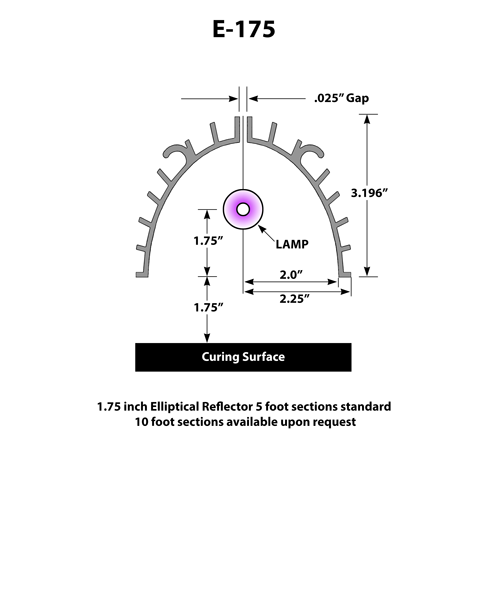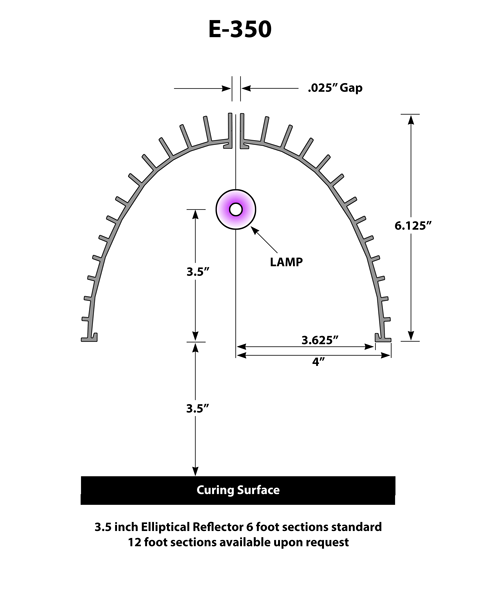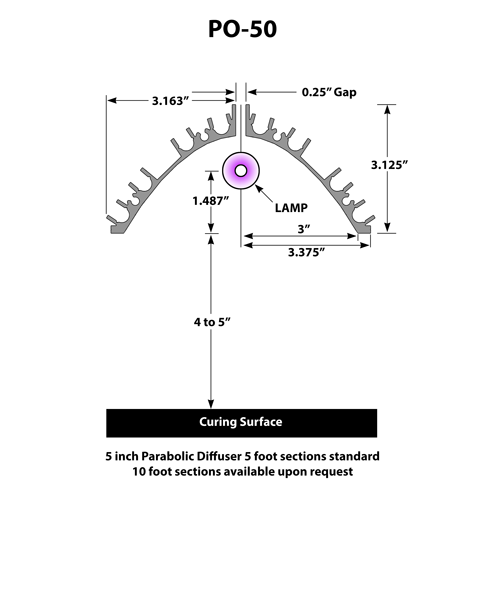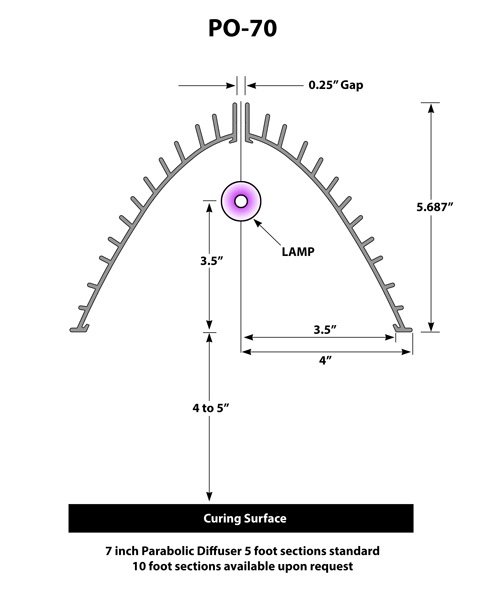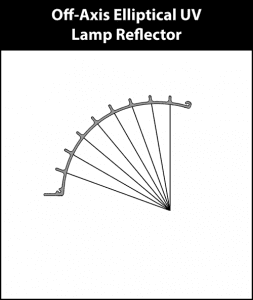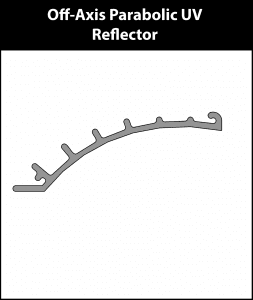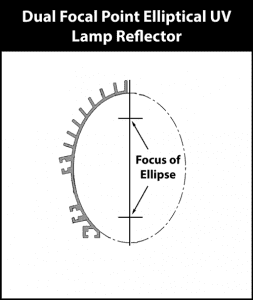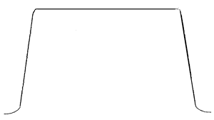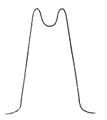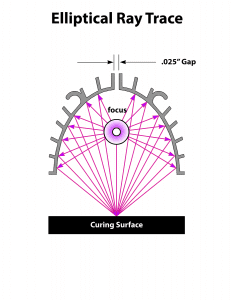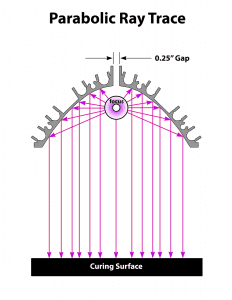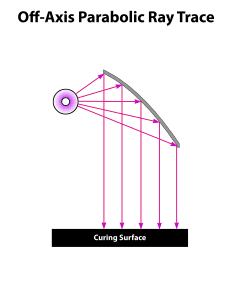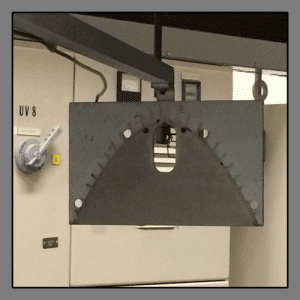UV Reflector Extrusions
Our highly polished Aluminum reflector extrusions allow engineers to cost effectively build their own UV curing system without investing in expensive extrusion dies, long lead times, and minimum draw charges. These profiles are time tested, proven designs, to focus UV light from medium pressure mercury and metal additive lamps on to a curing substrate. Medium pressure lamp power rating from 100 to 600 watts per inch are commonly used. Heat from the lamp is absorbed by the aluminum reflector and dissipated into the fin structure opposite the reflective face. For higher power applications it is best to enclose the reflector in a housing, using forced air-cooling to draw air from both ends to create an end cooled reflector assembly, or a center hole on the top of the housing to create a center cooled reflector assembly.
Our extruded reflectors are made of specially processed 6061-grade aluminum. The inside surface is highly polished to yield an efficient transfer of UV energy from the uv bulb to the curing substrate. This high UV reflectance is approximately 90% and unlike other aluminum, this special grade resists tarnishing and corrosion. Expensive UV reflector liners or reflector sheets are not required; however, these reflector sheets may be considered in extremely messy environments where ink or varnish spatter tends to degrade the reflector surface. Even in these cases, our UV reflector extrusions are very cost effective and tend to be less expensive than a new UV reflective liner. For this reason, only two of our four profiles come with provisions to accommodate reflective inserts.
Standard reflector length for 1.75 inch Elliptical, 7" Parabolic and 5" Parabolic Reflectors are 5-foot-long sections. 10-foot sections available upon request.
Standard reflector length for 3.5" Elliptical Reflectors is a 6-foot long section. 12-foot sections available upon request.
Custom length cuts are available for nominal cutting fee. These cuts are +/- 0.125 inches.
Note when ordering!Each aluminum reflector section is only 1/2 of a reflector assembly, for example:
Two 5-foot reflector sections will build one 5-foot reflector assembly.
Custom designs are also available, below are a few examples of custom profiles we have provided. We welcome your inquiries.
About UV Reflector Shapes
Elliptical aluminum reflectors provide a line source where one focal point is at the center of the UV lamp, the other focal point is at the surface of the curing substrate. The distance from the bottom edge of the reflector to substrate is 1.75 inches for our E-175 or 3.5 inches for our E-350.
Parabolic aluminum reflectors provide a collimated beam and the reflectors’ bottom edge, whether using the PO-50 or PO-70 reflector, should be located 4 to 5 inches from the substrate. For proper lamp operation, it is important that each half of the reflector is separated by approximately one quarter of an inch to allow for convection cooling.
Off-axis parabolic reflectors are available custom made to your requirements. These also focus a UV lamp into a collimated beam similar to a standard parabolic reflector, and can provide significant space saving. However, the tradeoff is a greatly reduced collection of the lamps’ UV energy but in some applications this tradeoff is worthwhile.
Spherical reflectors provide a non-uniform distribution of energy from UV lamps and are not offered by Hill Technical.
Types of reflectors and their respective beam profiles:
Ray Trace of different reflector profiles:
Creating a UV reflector assembly
The simplest UV reflector assembly is created by using two sections of our reflector extrusion fixed to plates on either end. The end-plates have mounting holes to fix to the reflector, and a “U” shape notch to gently cradle the UV lamp. End-plates can be fabricated out of plate aluminum stock, and screwed to fasteners held into the reflector, or threaded rods can be used, which extend the full length of the reflector.
It is imperative to position the arc lamp at the focal point of the extruded reflectors, by carefully locating the “U” shape notch in the end-plate. Because of the operating temperature range of medium pressure UV Lamps, they will physically expand upon turn-on, and then contract upon cooling. For this reason, it is important not to mechanically constrain the UV lamp; the lamp should just rest in this "U" notch for support.
See below assembly examples:
Reflector Example Application
Below is an example of how our UV reflectors can be mounted as part of an Irradiator or Reflector Assembly in a finished UV Drying system. These systems use a magnetic ballast or metal halide ballast to operate the uv curing lamp. A similar concept can be applied for ultraviolet blood irradiation, or other sterilization processes such as water sterilizers and air sterilizers.
Other applications The reflectors can also be used for low wattage germicidal UV lamp applications in free air. They have also been used with IR elements to focus infrared energy. However, the most common application is for focusing uv light from a medium pressure mercury vapor lamp, uv curing lamp, or metal halide lamp.
